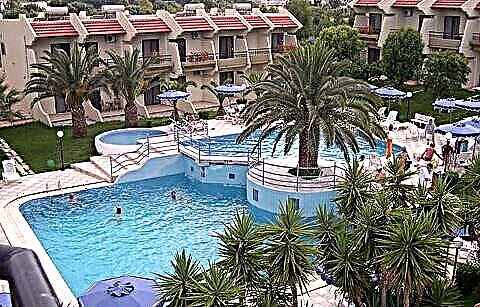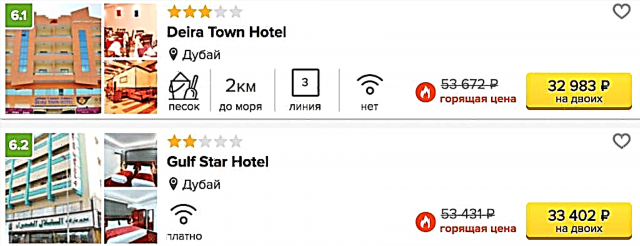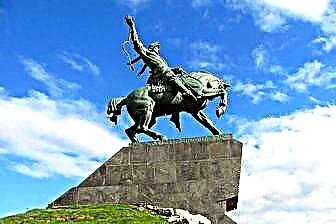It is worth going to Ufa just for the sake of its parks. No wonder the capital of Bashkortostan has the title of the greenest city in Russia. There are about a dozen large green areas here, enveloping residential quarters with a cloud of freshness. And this is not counting the squares, alleys and plantings in the yards! This is probably why it is so easy to breathe in Ufa, huge lungs absorb all pollution and harmful emissions.
If we talk about the architectural sights of the city, then there are not so many of them. Among them should be highlighted the Nativity of the Mother of God Church, Gostiny Dvor, the house-museum of S. T. Aksakov and several stone estates adapted for museums. The rest of the memorable places are the so-called remake, which, nevertheless, gives the Bashkir capital a modern and unique look.

The best hotels and hotels at affordable prices.
from 500 rubles / day
What to see and where to go in Ufa?
The most interesting and beautiful places for walking. Photos and a short description.
Monument to Salavat Yulaev
Salavat Yulaev is a national hero of Bashkiria, who fought for the independence of his people during the time of Catherine II. A monument in his honor was erected in 1967 on the Belaya River. The sculptor S. D. Tavasiev depicted the hero on horseback. Together with the granite pedestal, the statue is 14 meters high and weighs 40 tons. This is the largest equestrian sculpture in Russia. The monument stands at the highest point in the center of Ufa, it can be clearly seen from afar.

Fountain "Seven girls"
The sculptural group of seven maiden figures and two marble pools was created in 2015 based on the Bashkir legend of seven sisters who preferred death to captivity in the waters of the lake. The author of the project, Kh. Khabibrakhmanov, copied images from the girls participating in the folk dance ensemble. A screen is installed near the fountain, which broadcasts the performance of this group, as well as the natural attractions of Bashkortostan.

Sculpture "House of the marten"
A bronze composition dedicated to the symbol of the city - the marten. It was installed opposite Gostiny Dvor in 2010. The sculptural group is a tree with a small house in which two animals live: one of them looks out from a mink window in a friendly manner, the other, with its tail fluffed up, stands on the branches, as if greeting his comrade (or girlfriend?). The sculpture has become one of the places where wedding corteges come.

Lyalya-Tulpan Mosque
Muslim temple built in 1998, the spiritual center of Ufa. The building was erected with voluntary donations with the support of the republican authorities. The construction was designed by V.V.Davlyatishin in the form of a blooming tulip. Two minarets of the mosque resemble blossoming buds. Prayer halls are designed for 1000 people, there are also study rooms and a hostel.

Cathedral Mosque "Ar-Rahim"
The construction of the temple began in 2007 and is scheduled for completion by 2019. The building was laid in honor of the 450th anniversary of the entry of Bashkortostan into Russia. The architectural style can be defined as classical Islamic with national Bashkir motives. The interiors and exteriors were and are handcrafted using gilded decorative details and marble mosaics.

Nativity of the Mother of God Church
The main Orthodox church in Ufa and one of the most beautiful architectural monuments of the city. It was built in the late 19th - early 20th centuries. In 1934, like many others, it was closed, confiscating church property. In 1991, the building was returned to the believers, after which reconstruction began. Today, this picturesque sky-blue church with golden domes is a real decoration of the cityscape.

Congress hall
The modern building of 2007 in high-tech style, diluted with Bashkir national motives, which is also called the "House of Friendship of Peoples". It was built by order of the Republican Ministry of Culture. On its territory there is a museum complex, conference rooms, a restaurant with national cuisine, a winter garden, a shopping center and an underground parking lot.

Gostiny Dvor
Traditional shopping malls that seem to have existed in every more or less large city of the Russian Empire. Ufimsky Gostiny Dvor was built in the 19th century in the classical style. At the turn of the 21st century, it was adapted into a modern trade and business complex. In the 1980s, they even wanted to demolish the ensemble, but the public rose to its defense, thus, the architectural monument was preserved.

Ufa Arena
A complex designed for sporting events (mainly for hockey games) and concerts. It was built in 2007. Inside there are two ice rinks, premises for coaches and athletes, stands, parking. The arena is designed for more than 8 thousand spectators. It hosted many hockey championships, both world and federal levels, as well as matches between local teams.

Friendship Monument
Monument, founded in 1957 in honor of the 400th anniversary of the annexation of Bashkiria to Russia. Earlier in its place was located the Trinity Church blown up in 1956. The construction of the monument took a long time - it was installed only in 1965. A group of metropolitan sculptors and architects worked on the project. The composition represents an obelisk in the shape of a sword, bronze figures of women with wreaths in their hands, depicting Russia and Bashkiria, and bas-reliefs.

Russian Drama Theater of Bashkortostan
Ufa saw its first theatrical performance in 1772. During the 18th - 19th centuries, mainly amateur performances were performed in the city, but on a regular basis. The development of theatrical art in Ufa was largely facilitated by the help of local patrons of the arts. The first theater building with 400 seats was erected in 1861 from wood. Over the next decades, the scene moved several times.

Bashkir Opera and Ballet Theater
The opera stage has existed in Ufa since 1938. Today it is located in a building built in 1920, built according to the project of P.P. Rudavsky (the last reconstruction was carried out in 2014). This building is a historical and architectural monument of the capital of Bashkortostan. The premiere performance of the theater was an opera by the Italian composer D. Paisiello, performed in the Bashkir language.

Tatar theater "Nur"
Drama theater, focusing on the works of Bashkir and Tatar authors, both classics and representatives of the modern theater school. There are also works by foreign playwrights. It is believed that "Nur" was founded in 1912. The troupe toured extensively throughout the Russian Empire, but disbanded in 1918. The scene was revived in 1989.

Youth Theater. M. Karima
The theater was founded in 1989 as a Youth Theater. It has been located in a modern building since 2002. Since the opening, two troupes have performed here: Bashkir and Russian - each has its own repertoire and conducts performances in its own language. Over the years, the stage has taken part in many regional and all-Russian festivals. The main mission of the theater is to form a love for art and a sense of beauty among young people.

Drama Theater named after Mazhita Gafuri
Another dramatic scene in Ufa, officially established in 1914 in Sterlitamak and moved to Ufa in 1922. The theater building was erected in 1932 on the site of the destroyed church. Today it is considered an architectural monument. The repertoire is quite extensive and includes classical plays, works by national authors, as well as modern productions on topical subjects.

National Museum of the Republic of Bashkortostan
The collection is housed in a historic building from 1905, formerly owned by the Peasant Land Bank, which was closed in 1917. In total, the museum has 35 exhibition halls, where archaeological, ethnographic, natural science and art collections are located, acquainting the visitor with the history of peoples living in the territory of Bashkiria.

House-Museum of S. Aksakov
The museum exposition is dedicated to the personality of the Russian writer and public figure. It is located in a wooden house - an architectural monument of the 18th century, which once belonged to the grandfather of Sergei Timofeevich. The mansion was restored in the 1980s under the guidance of Moscow artists. The exposition was opened to the public in 1991. It is located in 14 rooms and consists of 3 thousand items.

Art Museum named after M. Nesterov
M. Nesterov - Russian and Soviet painter, a native of the capital of Bashkiria. In 1913, he gave the city a collection of works by artists of the early 19th - 20th centuries, taking care of the cultural education of his fellow countrymen. The museum was established in 1919 and opened to the public in 1920. The exposition consists of paintings by Nesterov himself, objects of ancient Russian art, painting of the XIX-XX centuries, modern works and national creativity.

Museum of Archeology and Ethnography
The collection is located on the territory of a 1910 mansion that belonged to the local merchant E.A.Ponosova-Mollo. This building was the first building in Ufa with elements of the Art Nouveau style (although its appearance is clearly dominated by classical and baroque features). The exposition is devoted to the archaeological and ethnographic history of the Southern Urals, as well as the culture and life of the peoples living on its lands.

Republican Museum of Military Glory
The museum is located within the Victory Park. It was opened in 2000 in honor of the 55th anniversary of the end of the Second World War. The building was completed in just 9 months. Thanks to its laconic and modern architecture, it harmoniously blended into the surrounding space. The collection is a collection of weapons, samples of military uniforms, personal documents, letters of soldiers and other thematic exhibits.

Victory Park
Memorial complex and park for walking and recreation, founded in 1947. In addition to the monuments to the heroes, there is a Museum of Military Glory and an exhibition of military equipment from the Second World War period: tanks, artillery installations, and BMPs. In winter there is a small ski slope. At any time of the year, the park hosts holidays and festivities. Also, newlyweds often come here for photo shoots.

Park named after Ivan Yakutov
An amusement and amusement park designed for the recreation of guests of all ages. Here you can ride a pony, rent a boat, ride a children's railroad, try yourself on a game stimulator and do a dozen other interesting things. The newlyweds can organize an off-site ceremony near the wedding tree, and arrange a solemn banquet at the Tikhaya Gavan restaurant.

Salavat Yulaev Garden
Another green area in Ufa that adorns the city and is intended for walking. The garden was founded in 1900: the descent to the river was ennobled, the territory was planted with oaks, birch, pine and lilacs, gazebos and cast-iron gates were installed. In the 1950s, pavilions and attractions appeared. In the late 1980s, the park fell into disrepair, but today, after reconstruction, it has again become a city landmark.

Park "Kashkadan"
A landscaped green area appeared in 2002 around the lake of the same name. It offers a well-equipped beach, walking paths, "Health Trail", rental of water transport, bicycles, rollers and other means of transportation, a variety of attractions. Various sports competitions, exhibitions, fairs, concerts are regularly held in "Kashkadan".

Park named after Mazhit Gafuri
The largest park in Ufa, covering an area of 29 hectares. It is divided into two zones: the first contains attractions and entertainment, the second is a refined forest plantation. In winter, various types of activities are available to visitors: ice skating and tubing. In summer, you can visit the horse base, ride the rides or spend time at the karting track.

Square named after Mustai Karim
In 2013, Ufa acquired another park - the square named after I. Mustai Karima, whose central composition is a sculptural group dedicated to the poet. There are fountains in the park, paths for pedestrians have been laid, and colorful flower beds with fragrant flowers delight the eyes of visitors. At night, the square is illuminated by a lighting system, which makes it even more picturesque.

Alexander Matrosov's garden
The park appeared in 1867 in the area between the governor's house and the cathedral, where livestock usually grazed. Apparently, the mayor did not like such a neighborhood, and he decided to ennoble the area, turning it into a recreational zone. Throughout the 20th century, the garden has changed its appearance more than once. Due to its proximity to several universities, the place is quite popular with Ufa students.

Ufa Botanical Garden
The city botanical garden was established in 1932 for the preservation of the region's plant diversity, selection of rare species, acclimatization of decorative and fruit species, as well as for scientific research. Since 1991, it has been functioning as an independent institution. You can come here as in a normal park for a walk to look at the diversity of fauna and appreciate the beauty of nature.

Park Aksakov
The park is located on the site of a public garden, founded at the expense of the merchant Blokhin in the 19th century. At that time, a wooden theater was located here. The main attraction is a small pond where swans live (a special house has been built for them). Fishing competitions are sometimes held on this reservoir, although independent fishing is prohibited. As in the rest of the Ufa parks, there are amusement rides.

White river
The white river is the deepest tributary of the Kama. It flows through the whole of Bashkortostan to the border with Tatarstan, its length is just over 1.4 thousand km. Local residents call it "Agidel", which is a direct translation of the Russian name into the Bashkir language. Within Ufa, the waterway is navigable. Belaya attracts many tourists who like rafting. Picturesque cliffs, caves and forests are located along its banks.











